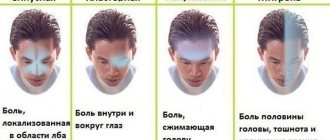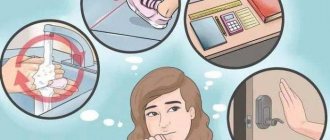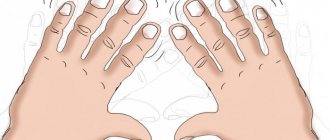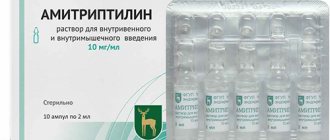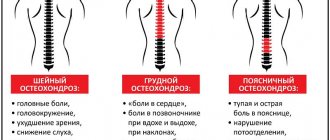Types of speech stereotypies
Several types of speech stereotypies are known: persistent repetition of one conclusion or word (perseveration), repetition of the same expression, figure of speech (standing turns), repetition of words or syllables in a certain rhythm or in rhymed form (verbigeration).
Perseveration - we sing odes to the persistence of the stubborn
The term perseveration comes from the Latin word perseveratio, which means “perseverance”, “persistence”. In speech, perseveration manifests itself as repeated reproduction of the same syllables, words or sentences.
A word or thought seems to be “stuck” in the patient’s mind, and he repeats it repeatedly and monotonously when communicating with his interlocutor. In this case, the repeated word or phrase is not related to the topic of the conversation. The patient's speech is monotonous. Perseveration can be expressed both orally and in writing.
Perseveration is the result of associative activity, part of consciousness and does not occur by chance. It should not be confused with obsessive phenomena, since the latter have an element of obsession, and the patient is aware of the absurdity of his actions.
Verbigeration is a common fate of schizophrenics
A mental disorder in which the patient repeats and shouts in a monotonous voice the same interjections, words, and phrases. These repetitions are automatic and meaningless and can last several hours or even days.
The patient rhythmically, often in rhyme, repeats words and combinations of sounds that do not make sense. Verbigeration should be distinguished from perseveration, since with the latter, repetitions depend on neuropsychic states, and disappear with the elimination of these states.
Standing speed
Standing phrases are fragments of phrases, expressions, words, and similar ideas that the patient repeatedly reproduces during a conversation.
At first, the patient pronounces them with the same intonation, and subsequently simplifies, reduces, and the process comes down to a stereotypical repetition of words.
Often the pronounced standing phrases are greatly distorted and it becomes impossible to understand their original meaning and sound.
Palilalia
Palilalia means the patient repeating a phrase, or part of it, a single word or syllable, from a fragment of speech he himself uttered, two or more times in a row.
Repetition occurs at normal voice volume; the volume may gradually decrease and the rate of speech become faster. For example, having given an answer to a question, the patient repeatedly and continuously repeats the answer.
Manifestations of palilalia relate not only to intellectual forms of speech, but also to emotional ones (exclamations, shouts). However, it usually does not refer to mechanically pronounced turns of automated speech. The number of repetitions can reach two dozen or more.
Echolalia
With echolalia, the patient repeats phrases and words that were said by people around him. Echolalia is often characteristic of young children, and in them it is not a pathology.
This is considered a pathology when echolalia causes mental retardation, or its development is observed in an adult.
ICD-9
ICD-9 had a category for “stereotypical repetitive movements” (307.3307.3)[2]. As described in the classification, the key feature of this diagnosis is repetitive stereotypic movements that are not associated with any mental or neurological disease[2]. Includes rocking, rotation, head nodding, nodding spasms, winking and finger tapping[2]. It mainly occurs in mental retardation with an underlying disorder or in a monotonous environment[2].
Speech stereotypies and psychoneurological diseases
The causes of speech stereotypies often lie in the development of neurological and psychological diseases.
Causes of perseverations
Experts believe that the cause of perseveration is damage to the lower parts of the premotor nuclei of the cortex of the left hemisphere in right-handers, and the right hemisphere in left-handers.
The most common cause of perseveration is considered to be neurological diseases resulting from physical damage to the brain. In this case, it becomes impossible to switch between different activities, changing the train of thought and the order of actions when performing various tasks.
With the neurological nature of the disease, the causes of perseveration are:
- Traumatic brain injuries , in which the lateral orbitofrontal areas of the cortex and its prefrontal convexities are affected.
- Aphasia is the appearance of disturbances in speech formed at a previous stage of life. These disorders arise due to physical damage to the speech centers, as a result of traumatic brain injury, encephalitis, and brain tumors.
- Pathologies related to the area of the frontal lobes of the cerebral cortex.
Psychiatry and psychology classify perseveration as a symptom of various phobias and anxiety syndromes. The course of this speech stereotypy in the psychological and psychiatric direction can be caused by:
- obsessiveness and selectivity of individual interests, which is most often found in people with autistic disorders;
- lack of attention with hyperactivity, while stereotypy arises as a defense mechanism to attract attention to oneself;
- a steady desire to learn and experience new things can lead to fixation on one conclusion or activity;
- Perseveration is often a symptom of obsessive-compulsive disorder.
Perseveration should not be confused with obsessive-compulsive disorder, human habits, and sclerotic changes in memory.
Perseverations are more often observed in patients with dementia (dementia), which is caused by vascular damage to the brain, as well as with age-related atrophic processes in the brain. The patient’s intellect is impaired, and he cannot understand the question being asked and, instead of a logical answer, repeats previously used phrases.
What provokes the development of verbigeration?
With verbigeration there is no connection with certain neuropsychic conditions. One of the features of verbigeration is that the patient pronounces words without showing emotion. As a rule, verbal repetitions are accompanied by active facial expressions and motor disturbances.
Most often, these verbal iterations occur in patients with dementia and catatonic schizophrenia.
Causes of standing revolutions, palilalia and echolalia
The appearance of standing phrases in speech signals a decrease in intelligence and empty thinking.
They often appear with a disease such as epileptic dementia. Also, one of the diseases characterized by standing movements is Pick's disease, as well as other atrophic diseases of the brain. Palilalia is a typical manifestation of Pick's disease. It is also often accompanied by diseases such as striatal pathology, striopallidal pathology (atrophic, inflammatory, vascular), postencephalic parkinsonism, pseudobulbar syndrome, catatonia, Tourette's syndrome, schizophrenia.
The occurrence of echolalia is often associated with damage to the frontal lobes of the brain. If the patient has symptoms such as hallucinations, lack of coordination, and forgetfulness, it is necessary to seek advice from a specialist. If brain damage is not diagnosed, then the causes of echolalia may be imbecility, schizophrenia, autism, Asperger's syndrome, Tourette's syndrome.
What does it look like from the outside?
Stereotypical movements in healthy children and adults are manifested in rapid fingering; a person can very often move and jerk his legs, scratch his ears, lick, and bite his lips.
In children, the syndrome also manifests itself in a different way: by putting fingers in the mouth, turning the head in different directions, staggering in one place, twisting or pulling out hair, the child constantly strives to break his head, and bite his nails.
Under normal circumstances, these symptoms disappear with a certain age, approximately between four and seven years, but it is not uncommon for them to occur when the child is quite mature.
With such deviations, all body movements are longer and sharper. Such symptoms indicate a separate disease that has a number of different causes.
Often movements that are repeated intensify with strong nervous excitement, but can develop even in a state of complete relaxation.
Possible courses of action
Repetitive and stereotyped actions and movements appear in several forms:
- Sensory-motor stereotypies - children constantly scratch their eyes, turn in circles, the child rocks, feels the walls, makes rhythmic sounds.
- Speech stereotypies are constantly repeated words and sentences.
- Motor stereotypies - running, staggering, clapping hands, flapping, fingering, incorrect foot placement when walking.
- Emotional and affective manifestations of the syndrome are most often observed in children; they perform actions with parts of objects or components of toy material - sand is poured from one place to another, wheels on toy cars are unscrewed, water overflows from place to place.
- Specific habits, rituals . Children often make sure that doors are either constantly open or closed, wear the same clothes, always follow the same route, and do not change their diet.
Stereotypy and child behavior when present
The child becomes socially maladjusted. Impossibility, oppression in the impulse to feel one’s stereotypes causes problems in behavior.
Such a child has limited ability to adapt to living conditions that are constantly changing.
Establishing diagnosis
Diagnosis of speech stereotypies involves comprehensive testing. The patient is asked to undergo special testing or answer simple questions (implying “yes” or “no” answers), repeat similar-sounding sounds or sound combinations.
The patient is also asked to name the objects that are in the room, name the days of the week, explain the meaning of the words, and retell the text.
When examining a patient, it is very important to determine whether he understands speech addressed to him. If there is a suspicion of mild forms of speech disorders, the speech pathologist uses other more complex diagnostic methods.
To diagnose speech stereotypies, a technique is used that includes a series of separate tests. The patient is asked to write words in normal and reverse order, write words and phrases in upper and lower case letters, read text in forward and reverse order, write numbers in normal and reverse order, and perform multiplication. When making toasts, the doctor assesses the number of correct and incorrect answers per minute.
Biochemist mother relieved daughter of autism symptoms
3 minutes
3833
Biochemist Katherine Reid from San Francisco has discovered a remedy that in some cases can minimize the symptoms of autism in children - a diet that excludes monosodium glutamate, Fox News reports. Her findings are based on an analysis of neurobiological research and her own experiences: her daughter was diagnosed with autism at the age of two; She is now seven years old, and, according to the scientist, the symptoms of the disease have “completely disappeared.”
Since there is currently only one drug (risperidone and its analogues) approved by the US Food and Drug Administration (FDA) for the treatment of autism spectrum disorders, many parents of autistic children are turning to alternative medicine, using homeopathic medications, probiotics, and various gluten-free diets ( gluten), lactose and casein in the hope that this will have a positive effect on the child's condition.
The diet that Dr. Reed is talking about is different from those that have been known so far. In her opinion, only one chemical compound should be excluded from the diet of an autistic child - the food additive, taste and aroma enhancer monosodium glutamate (other names - E 621, E 631, hydrolyzed vegetable protein). “The body has receptors for glutamate, which excites nerve cells, and it is needed, but only in a certain amount,” Reed said. “Many neurodevelopmental disorders, such as autism, may potentially be associated with imbalances in glutamate intake.” She said 95% of processed foods contain MSG, but manufacturers have the right not to indicate its presence unless it exceeds a certain level.
Although there is currently no scientific evidence to support Reed's theory (the glutamate hypothesis of autism, however, already exists), the biochemist considers the return to normal condition of his seven-year-old daughter Brooke as clear evidence of the correctness of this idea. When the girl was two years old, Katherine and her husband, a cell biologist, began to notice signs of autism in her: wild tantrums that lasted for hours on end, stereotypical behavior, difficulties in communication and learning, and problems with bowel movements. The examination showed that the child has moderate severity of autism. “She lived in her own world,” Brooke’s mother said. “Her behavior was repetitive, she showed signs of obsessive-compulsive disorder and would start screaming hysterically if I took her home along a different route than usual.”
Reed quit her job and began researching different diets recommended for children with autism, first by eliminating foods containing gluten and lactose from her child's diet, then by adding magnesium, vitamin D, fish oil, and B complex vitamins to her diet. , and all these approaches helped, but only a little. She later came across an article on the effects of glutamate on the human body, which noted that although this compound is necessary for the transmission of impulses between neurons and cells of other tissues and is involved in the cognitive processes of the brain, its excess can cause various neurological disorders. So Reed eliminated foods containing monosodium glutamate from the girl’s diet, and, in her words, “her autism symptoms completely disappeared.” Gradually, the child became more socially adapted, his stereotypical behavior completely disappeared and his coordination improved.
Sanford Newmark, a physician at the Osher Center for Integrative Medicine at the University of California, San Francisco, who specializes in treating children with autism, noted that there is no scientific evidence to support this theory. However, he is willing to give it a try because he has seen positive results with a gluten- and casein-free diet.
“There's a lot we don't know about autism,” he said. “But the work of the intestines and the brain are closely related, and it often happens that by relieving a child of gastrointestinal problems through diet, his general condition can be improved. There is no harm in trying to switch to an MSG-free diet - if you eat fruits, vegetables, meat, beans and whole grains and eliminate processed foods, it will be a healthier diet." “We need to be open to new approaches to treating autism,” also says psychiatrist and autism neurologist Antonio Hardan of Stanford University Children's Hospital.
After Reed saw the results of switching to a glutamate-free diet in her daughter, she founded Unblind My Mind, a nonprofit organization that studies the effects of food on the brain. According to her, 74 of the 75 children with whom she worked as part of this organization showed significant improvement in their condition.
Therapy and correction
Treatment of patients with speech stereotypies involves the following techniques:
- pharmacotherapy;
- physiotherapy;
- psychotherapy;
- psychological correction;
- physiotherapy;
- logotherapy;
- working with defectologists.
It is necessary to begin therapy with treatment of the main provoking disease. The ability to restore speech function will depend on the main diagnosis.
If the patient has aphasia, the main emphasis is on automated speech, then the patient is gradually taught to comprehend and separate the main from the secondary. If the underlying disease is dementia, during therapy they focus on the semantic meaning of words. Patients with a mild form of schizophrenia are taught to correctly construct sentences that preserve semantic content.
In Western countries, when treating these disorders, the main emphasis is on drug therapy. Neuroleptics are the most widely used. They contribute to changes in the pathological processes of the brain.
Wrong question
“How to stop stereotyping?” This is usually the first question parents ask when a young child discovers stimming. And this is the wrong question.
First, all people have self-stimulating behavior, so it is basically impossible to completely stop it. Secondly, even if you get rid of one stereotype, another will replace it - and there is a risk that the next stereotype will be much more problematic.
And most importantly, your attempts to stop stereotyping may make your child want to avoid you and communication with you, as a result, you will lose opportunities for social interaction.
Features of stereotypical perception
Thinking through stereotypes has the following features:
- The effect of projection, the essence of which is that when communicating, we endow people who are unpleasant to us with our shortcomings, and our advantages - with people who are pleasant.
- The average error effect involves averaging the salient features of another person.
- An order effect, in which when communicating with an unfamiliar person we give more trust to primary information, and when communicating with an old acquaintance - to fresh data.
- The halo effect, or judging a person based on one of his actions (good or bad).
- The effect of stereotyping, or endowing a person with characteristic (stereotypical) traits for a certain group, for example, focusing on the person’s profession.
The skin vector provides a healthy baby with amazing mobility and dexterity, and good motor skills. From birth, these babies have especially sensitive skin, receptive to the slightest touch. Physical punishment represents unbearable suffering for a skinned child; they should never be beaten.
Children with the skin vector have an engineering mindset. From early childhood, they enthusiastically build something, be it the first tower made of cubes or a complex spaceship from all the furniture that comes to hand in the house. They have excellent rational thinking, based on an innate sense of benefit and benefit.
What happens when the skin vector develops under conditions of sound trauma, that is, in childhood autism?
If we are talking about primary autism (that is, the child received sound trauma in the womb), then from infancy not only the disorders characteristic of any autistic person are visible (does not respond to the name, insufficient eye contact). At the same time, other unfavorable symptoms associated with the distorted development of the skin vector increase.
Having especially sensitive skin, such children from infancy protest with a cry against the usual procedures of swaddling, bathing, combing and cutting nails and hair. Stroking or light massage also causes them great discomfort. Many mothers of skin-sound autistic children note that when feeding, the child twists and turns in his arms, as if trying to get rid of the mother’s embrace. It was possible to calm the child down only by placing him next to him on the bed, after which the baby could take the breast.
If autism develops in a child after birth, symptoms appear later. The child also begins to protest even during the procedure of washing and dressing. He often has the desire to completely remove his clothes and be naked, regardless of the air temperature in the house. One gets the impression that any kind of touch is unbearable for him.
This is confirmed by another observation from parents - the child categorically protests against hugs and kisses, and cannot stand sitting in the parent’s arms for more than a few seconds.
Paradoxically, at the same time, a child often experiences great pleasure from such games with adults, when he is tossed, twirled, and twirled. In this case, there is no emotional contagion from an adult’s smile. Presumably, joy comes directly from the sensations of one's own body.
In fact, this is how an autistic child with a cutaneous vector gets his first experience of motor autostimulation. But sometimes skin-sound children with an injured sound vector from an early age learn to receive similar satisfaction of their needs without the participation of their parents: for example, they bang their heads against the side of the stroller or their backs against the wall of the playpen.
From an early age, they also begin to experience a special pleasure from rocking: such a child can rock back and forth for hours while sitting in a playpen (this may be explained by the fact that the skin vector is responsible for rhythm, movement, tact).

